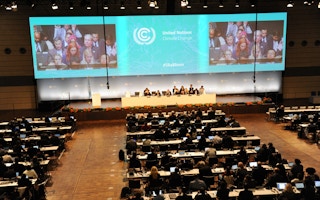Delegates from the world’s governments are meeting in Bonn for the latest global conference on tackling climate change.
To continue reading, subscribe to Eco‑Business.
There's something for everyone. We offer a range of subscription plans.
- Access our stories and receive our Insights Weekly newsletter with the free EB Member plan.
- Unlock unlimited access to our content and archive with EB Circle.
- Publish your content with EB Premium.
Negotiations will be critical for the success of the Paris Agreement, a climate pact signed by more than 200 countries to keep a lid on global warming.
There are two outcomes that delegates hope to achieve in Germany’s former capital: the finalisation of a rule book for the implementation of the Paris climate deal, and revised country pledges to cut emissions beyond previously declared Nationally Determined Contributions (NDCs).
The implementation rules are shaped around six key issues that government negotiators will need to agree on: transparency of implementation, mitigation, adaptation, technology, capacity-building, and financing.
“
Even the best rules in the world won’t save us if countries aren’t willing to commit to stronger action.
Mark Lutes, senior global policy advisor for climate and energy, World Wide Fund for Nature
Li Shuo, senior global policy advisor, Greenpeace, said on the sidelines of the event in Bonn that countries need to agree fast on this range of technical issues, amid a widening gap between current pledges and what climate experts are indicating is necessary to limit global warming to 1.5 degrees Celsius.
Without additional efforts to reduce greenhouse gas emissions, global emissions growth is expected to persist, driven by human population growth and economic activity, scientists from the Intergovernmental Panel on Climate hange (IPCC) have warned in their latest report.
“Countries need to sort out certain tasks under the transparency framework, particularly whether and how flexibility should be granted to developing countries in implementing their national climate goals,” he said.
“We need to know how scaled up finance and technology support will be mobilised,” he added.
A key result he is expecting from this Bonn conference is a “clear legal text,” or a draft of the rulebook which needs to be finalised in December this year during COP24 in Katowiche, Poland.
Dharini Pharthasarathy, senior communications coordinator for non-profit Climate Action Network, told Eco-Business in an interview that some countries want to follow a universal approach at implementing the Paris Agreement, where one rule applies to all, whereas others are proposing an approach that is based on equity and flexibility, where the least developed countries are given “leeway on the implementation of their Nationally Determined Contributions.”
As well as hastening the creation of the rulebook, experts and observers in Bonn are also calling for governments to radically step up climate ambition amid analysis that the window to avoid breaching the Paris Agreement’s 1.5 degrees Celcius threshold is closing fast. By some estimates, less than four years remain, and current pledges are projected to result in 3 degrees Celsius warming if unchanged.
This makes the original NDCs “woefully inadequate to reach the Paris goals,” Pharthasarathy said.
“All the countries’ pledges to lower emissions put together will fail to deliver on the ambition of the Paris Agreement. It’s been almost three years since they first wrote their pledges and climate change has only gotten worse within this period of the time,” she said.
Talanoa: The 3 questions that will make Paris work
To help scale up a country’s emission reduction ambitions, the Bonn conference will highlight the Talanoa Dialogue which, for the first time, will gather country negotiators, business leaders and civil society groups in a face to face meeting to discuss what is a fair and adequate—but scaled up—contribution from the different countries to reduce emissions.
The Talanoa Dialogue will take place on Sunday May 6 and is organised around three questions: 1) where we are?; 2) where do we want to go?; and 3) how do we get there?
Aside from the face-to-face meetings, parties and civil society members can submit their input to the Talanoa Dialogue via an online portal.
Pharthasarathy cautioned that the dialogue should not only be about a talking shop, but should encourage the countries to revise their NDCs as soon as possible—by 2020 at the latest.
2020 is defined as the year emissions must peak and then start to decline.
“The Talanoa Dialogue really needs to serve the purpose of enabling countries to scale up their targets because otherwise it’s just a sharing of ideas.”
“Countries will need to look at which sector of the economy they can start looking to reduce emissions in and put those targets in their NDCs,” she said.
2017 was the costliest year ever in terms of damage caused by climate change as well as the third hottest on record. Large tracts of the world’s oceans are being suffocated, and according to World Bank estimates, hundreds of millions of people are at risk of being displaced over the coming decades.
Mark Lutes, senior global climate policy advisor for climate and energy at World Wide Fund for Nature said that the climate talks in Bonn must pave the way to the Paris Agreement outcomes at COP24 at the end of the year.
“Even the best rules in the world won’t save us if countries aren’t willing to commit to stronger action,” he said.










